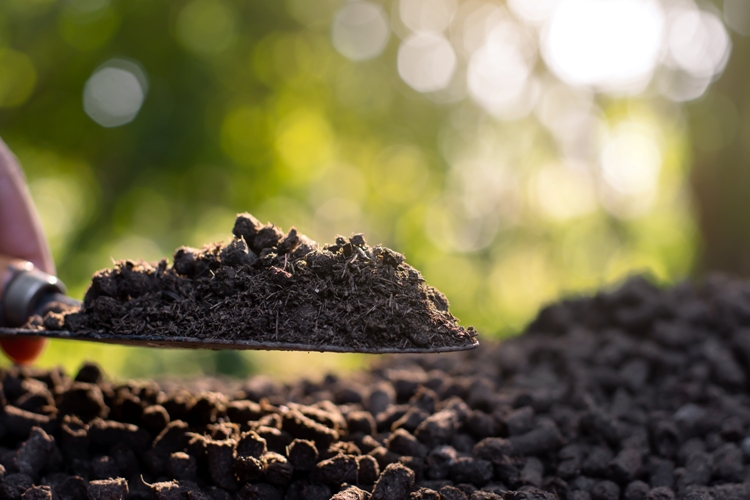High-quality, fertile topsoil is rich in soil organic matter. Soil organic matter (SOM) is formed by the biological, physical and chemical decay of organic materials on the surface and below the soil. This comprises of plant and animal remains at various stages of degradation, the cells and tissues of soil organisms, and the substances produced by soil organisms. Soil organic matter is a vital part of our soils, helps soils hold onto water and nutrients, and supports and provides food for soil microbes that recycle nutrients. Carbon in soil organic matter in the USA is vital for plant health.
How do we increase soil carbon levels?
The easiest way to increase the soil carbon levels is to incorporate excellent organic matter into soil layers, by methods like maximizing ground cover and mulching. We can also add carbon-rich inputs to increase the amount of SOM comprised by composts, humates and other products like vermicast. These products can energize the soil biology and feed the soil rather than just providing the plant. This is an essential strategy, but we must also enhance the microbes that play a crucial role in soil development and humus formation. Specifically, fostering a diverse soil flora can accelerate soil regeneration and build SOM levels. While plants are the carbon source for soil, microbes control their fate by using them as food, thus ensuring that at least some will remain in the soil. To ensure we are looking after the microbes, we need to think about no-till or minimal-till systems where possible, using biologically friendly fertilizers and stimulants like EM to boost this activity.

What is soil carbon saturation, and what does it depend on?
The soil carbon saturation level is the maximum amount of carbon a soil layer can attain. The level of carbon in the soil layer can only increase if the mechanisms through which the soil organic carbon is stabilized are limited. The soil organic carbon content is mainly dependent on the soil mineralogy (content of sand, silt, and clay), the input of organic carbon (e.g. from vegetation and fertilizers) and the soil environment (e.g. oxygenation, water content).
How can you increase soil organic carbon?
The benefits of soil organic carbon content are numerous. However, the question remains of how the farmers can increase the amount of carbon in their soil. One of the first things to consider is the carbon cycle at a fundamental level. It’s essential to note that carbon is always coming in and out of the soil. The quantity of soil organic carbon is the net balance of how much organic carbon content is put into the soil, mostly from plants, like dead leaves, roots, and compounds released by living roots, and how much of it is removed by harvest or are returned to the atmosphere in the form carbon dioxide by the microbial processes. Therefore, the goal is to add more quantities of carbon to the soil than you lose to the air or remove through harvest.
Soil Organic Carbon management and modern technologies:
Modern technology, specifically AI-powered satellite data analytics, is pivotal in overcoming the challenges of evaluating soil carbon sequestration. Satellite images provide very high-resolution data on SOC levels across large geographical areas. AI models also analyze historical and current data to predict the changes in SOC levels based on various factors like land use, climate, and management practices. Then, the valuable insights AI-powered satellite analytics provide can guide farmers toward more sustainable and highly carbon-efficient practices.
On a larger scale, reliable data on the health of soil and carbon sequestration can inform policy decisions promoting the sequestration practices that mitigate climate change. Advances in technology have also led to the introduction of the carbon market as a way to stimulate SOC sequestration.
In conclusion:
Soil is the most essential terrestrial carbon sink. A carbon sink is a component of the natural environment that stores the carbon and keeps it out of the atmosphere. About 2500 gigatons of carbon are held in soil globally, dwarfing the carbon currently in the atmosphere or residing in terrestrial organisms. Understanding carbon in soil organic matter in the USA, which represents the organically derived portion of carbon in the soil, is critical to understanding the carbon cycle.
Carbon continuously cycles between the soil layer, living things and the atmosphere. This cycle is heavily influenced by soil moisture, temperature and microbial activity.
As temperatures become warm and precipitation patterns change, it will impact the carbon storage potential of the soil.
Therefore, you must keep regularly analyzing the carbon content in your farm or agricultural land’s soil layer. For the most reliable outcomes, trust our experts at SoilOptix®. Get in touch today!
